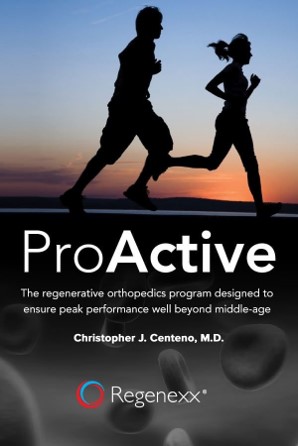Recovering from Orthobiologic Injections: My Journey

Credit: Shutterstock
One of the biggest questions patients ask every day is what can I expect when recovering from my Orthobiologic procedures? What does that look like? Let’s learn a little today by seeing how I’m doing today after my procedures this week. Let’s dig in.
Staying Ahead of the Aging Curve
As I get older and begin to approach 60 in the next few years, my accumulated wear and tear talks to me more and more. In that way, I’m a bit like lots of aging people who just want to stay active as they age, but their body isn’t always cooperative. Everything I’ll talk about today I’ve discussed in my book called “ProActive”:
Click on the image above to read the book.
My Aging Body
The biggest lesson from the ProActive book is staying ahead of these small problems when they’re small and not letting yourself get to the point where you need surgery. For me, it’s my back, neck, right knee, and left shoulder. Today we’ll focus on the knee and shoulder. These parts were in two different states of disrepair.
Early Intervention or A Bit Later?
Getting on It Early
My right knee was in the place where it ached mildly when I worked out. However, it wasn’t really taking me out of the game very often, but I did notice something that let me know things weren’t quite right.
A few times I noticed that my knee got in the wrong position and blew up. Meaning something as simple as sitting a weird way and getting up quickly got it fired up for days, but hiking 10 miles a week only made it mildly achy. As I result, while I know I have mild arthritis there, I realized my issue was likely an unstable joint. Meaning a normal knee doesn’t get out of position easily like that, so my ligaments were too loose.
Sure enough, when I had my knee examined by one of our doctors months ago, the ACL and MCL ligaments were lax. I had the knee injected about 2 months ago with high dose PRP into those ligaments and it responded well, but still had issues. A repeat exam showed some continued laxity, so I had it reinjected this week.
What did the recovery look like? I worked out that night with my trainer, but we stayed away from the knee. I had significant soreness that first night and needed Tylenol and had broken sleep because of the moderate pain. By the next day, I was walking with some slight hesitation and noticed that knee less, didn’t work out that day, and by the night I had better sleep on Tylenol. Yesterday I worked out on that knee and I did 30 minutes on the Peloton. I green-lighted those activities because off Tylenol it wasn’t that sore. So I played through, going a bit easier on the knee, but working out at almost full tilt.
A Bit Late to Intervene?
My left shoulder is a different story. Because I lift heavy weights, I have dreaded getting a full treatment of this shoulder with more aggressive injections in my tendons. Why? I knew it may take me out for a week or more. Hence, I’ve let this issue smolder longer, letting it get to the point that working out certain ways would cause moderate shoulder pain. Meaning, I didn’t follow my own advice in my ProActive book by getting this problem addressed early.
Because of that delay, my shoulder is on a different recovery curve. It began more painful and sure enough, here we are at day three and I’m still taking intermittent Tylenol. So let’s review what I’ve done.
Right after the procedure, I did a light upper body workout, which was possible, but I paid for it a bit that night, despite Tylenol. The next day I did nothing and then yesterday, it was too sore for an upper body workout, so we focused on the lower body. The good news is that the second and third nights I didn’t need Tylenol to stay asleep. However, the shoulder is still too painful for me to reach overhead and while it gets 10-15% better every day, it’s still intermittently painful when sitting with poor posture.
This weekend I’ll stay away from working out my upper body and take it easy with the shoulder. I expect it to be back to be able to lift by next week. However, I’m having to “listen to my body” more on this one because it began so much more painful than my knee.
Listen To Your Body 101
My number one advice to patients after these procedures is that you need to become a student of listening to your body. What does that mean? It means taking it VERY slow and if you’re sore, do less, but if you’re feeling good, then do more (within reason). So let’s examine how that worked out for my knee and shoulder.
For my knee, by day two, it was feeling good enough for a light lower body workout. Meaning it wasn’t hurting during the initial phase of that workout, so I went a bit further.
For my shoulder, it was clearly telling me that my day two workout on the upper body was way too aggressive. Hence, I canceled my plan and focused on my lower body. On day three it doesn’t yet feel like it’s able to do that and my guess is that this weekend it won’t be in that category. It’s more slowly improving. Here I want to make sure I can lift my arm over my head with only very mild discomfort (how it was prior to the injection) before I green light more activity.
The upshot? Listening to your body is the key to staying as active as you can while you heal. Even if that means that one part of my body is on a different recovery journey than the other.

If you have questions or comments about this blog post, please email us at [email protected]
NOTE: This blog post provides general information to help the reader better understand regenerative medicine, musculoskeletal health, and related subjects. All content provided in this blog, website, or any linked materials, including text, graphics, images, patient profiles, outcomes, and information, are not intended and should not be considered or used as a substitute for medical advice, diagnosis, or treatment. Please always consult with a professional and certified healthcare provider to discuss if a treatment is right for you.
